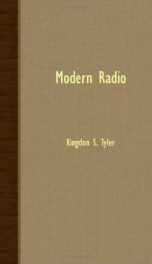modern radio

MODERN RADIO - 1944, ---- THE STUDIO STUDIO DESIGN SOUND EFFECTS MICROPIIOKES CONTENTS STUDIO CONTROL ROOM HOW RADIO TUBES OPERATE MASTER COKTROL ROOM THE BROADCASTING TRANSMITTER BROADCAST ANTENNAS BROADCAST RECEIVERS FREQUENCY MODULATION INTERNATIONAL TRANSMITTERS TELEVISION STUDIO THE TELEVISION CAMERA THE TELEVISION TRAXSMITTER COLORED TELEVISION RADAR RADIO TOMORROW INDEX 1VODERN -RADIO The Studio T HIRTY million families listen to radio programs every day, but few people listening in have any idea how modern radio stations, networks, and receivers operate. Even people who visit broadcasting studios usually come away more mystified than they were before. It is true that radio is a complicated science and a science that is constantly developing and changing. It is also true that some of the scientific problems involved cannot be fully explained even by scientists. But much of the mystery of radio can be cleared up if each operation, from the original broadcast to its reception in your home, is explained separately. Starting with the studio where the program originates, we shall follow the program to the control room, to master control, then out along the telephone lines to the t transmitter, to the transmitting antenna or radiator, to your re- ceiving antenna, through your radio set to the loud-speaker in your home. Radio has made tremendous strides in the last few years. 3 Modern Radio Studios have been designed where the quality or tone of a pro- gram may be changed,by merely pressing a button. Echo chambers and echo machines have been invented that make a voice sound as if it were coming from a cave or from the bottom of a well. Sound effect machines can reproduce the sounds of soldiers march- ing, thunder, subway trains, a man being stabbed, and hundreds of other sounds. New types of microphones have been developed. New master control switching facilities have been designed to handle the ever-increasing number of programs coming from studios all over the country and by short wave radio from Europe and South America. New types of antenna systems have been invented. The studio itself, the quality of the radio equipment, the skill of the technicians, the directing and timing, and many other things affect the production of any program. The variety of programs affects the design of the studio and the radio facilities that go into it, and the type and number of studios that a large broadcast- ing company must have. If you have ever been to a radio broadcast, you probably have noticed that each actor or actress reads the lines from a script. This might leave you with the false impression that very little rehearsing is necessary to produce a radio show. Reading the script does save the time that would be required for each actor I or actress to memorize the lines, but a great deal of time is still spent rehearsing...
Info about the book
Author:
Series:
Unknown
ASIN:
B000OT7FEG
Rating:
4/5 (5)Your rating:
0/5
Languge:
English
Users who have this book
Users who want this book
What readers are saying
What do you think? Write your own comment on this book!
write a commentif you like modern radio try:
Other books by this author
Do you want to read a book that interests you? It’s EASY!
Create an account and send a request for reading to other users on the Webpage of the book!


